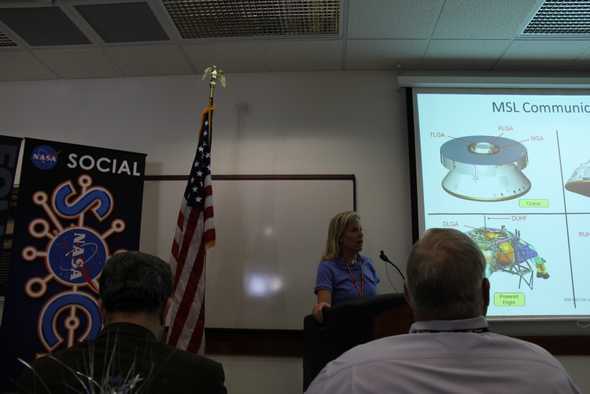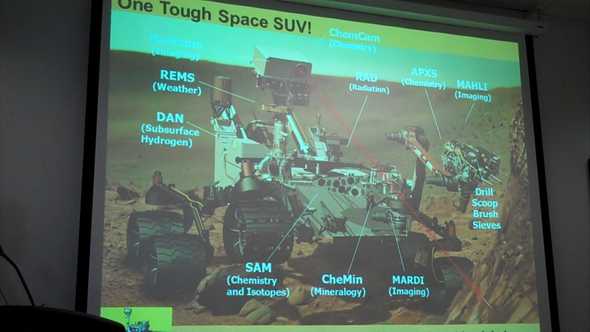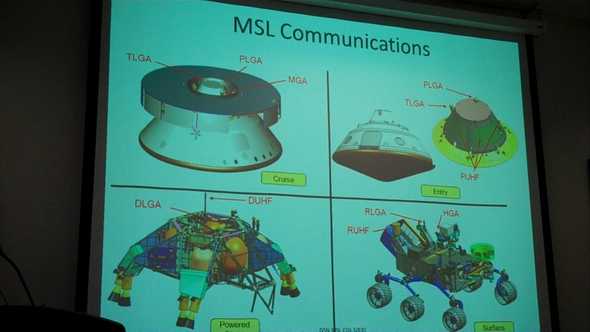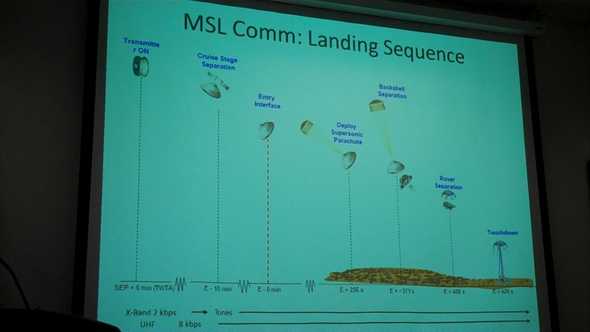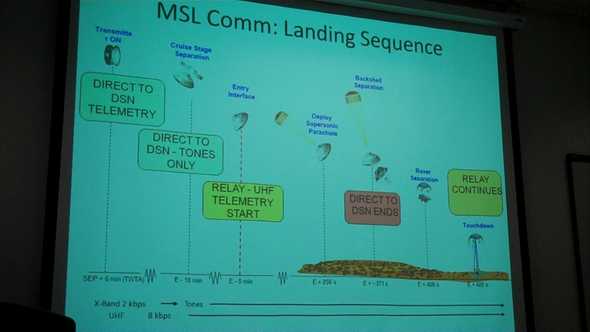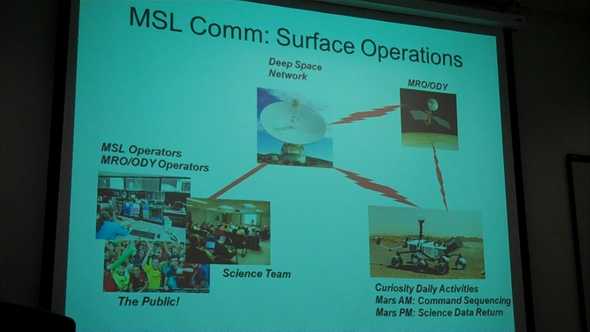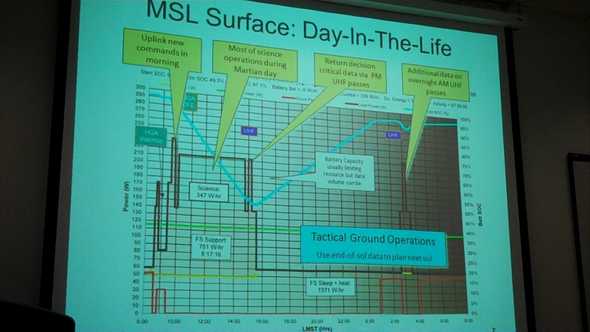Goldstone #DSN: Ann Devereaux and Mars Curiosity
At the Goldstone NASA Social, we were treated to a very fascinating talk by Ann Devereaux who has worked on the Mars Science Laboratory (MSL) mission for eight years. She has been a Lead Flight System Engineer, responsible for the thermal, power, and communications avionics on board the spacecraft. She is now the Deputy for the Entry, Decent, and Landing system. Her team has designed and built two of the UHF radios on MSL and the radio on Mars Reconnaissance Orbiter (MRO).
Devereaux started by describing MSL like a child. You teach a kid everything you know, right from wrong, how to keep themselves warm, and how to keep themselves fed. You send them to college and now they are far away from home. You assume they are doing well, but unless they call, you don’t actually know that. They call, tweet, IM, Facebook. But that has to go through the interwebs. The Deep Space Network (DSN) is their interwebs. The DSN is what allows Curiosity to keep the team always up to date on her status.
She pointed out that there are a number of antennas buried inside the belly of Curiosity that can be used. When Curiosity was in her cruise phase, the TLGA, PLGA, and MGA could talk back to the DSN. For the first few weeks after launch Curiosity talked to the DSN continuously. After that, every few days, unless there was a big event.
The Jet Propulsion Laboratory performed a software load part way through cruise that gave MSL more capabilities for landing and for early surface operations. That was one instance when they put the spacecraft into a sketchy mode. The team requested continuous coverage from the DSN to be able to make sure that things were happening as they planned.
The spacecraft went into safe mode at least once during cruise, with a data rate of 40bps. Devereaux described it like talking to someone on the phone and just when you hear a loud screech and a crash, the other side is not talking to you. The spacecraft could be limping along, there could be something wrong with the computer, the spacecraft could be in a funny attitude so the antennas aren’t pointed back to Earth, etc.
In this case, you may want to blast a signal up to the spacecraft and that’s where the DSN comes in with the big transmitters. By blasting a signal, or increasing the strength of a signal, you increase the chances talk to the spacecraft. And vice versa, if MSL isn’t talking that well because something is wrong with a radio, we need those big ears on the ground to be able to pick up weak signals. By dropping the data rate, they are able get a little more power into the signal, giving the DSN a better chance of receiving the signal.
When MSL went into the Entry phase, she picked up a new capability called Relay. The spacecraft actually has two separate sets of communication equipment on board. One is the X-band, a higher frequency signal that generally provides a better data rate except over long distances. The High Gain Antenna is used to talk to the DSN directly. For surface operations and when the spacecraft was near the surface, the DUHF antenna was used at 400mHz to talk to the orbiters overhead.
MRO and Mars Odyssey are two orbiters that help relay signals from the surface of Mars back to the DSN. Not only can MSL not carry large communication equipment with her, but as Mars rotates there are some moments when the spacecraft cannot physically see the DSN because the planet is in the way. Utilizing the orbiter’s higher orbit provides more time for data transfer. The orbiters also have bigger solar panels, transmitters, and antennas than Curiosity.
Curiosity has the capability to talk directly to DSN and to the orbiters when visible. She has started talking to Mars Express, a European mission that also has a radio on board and communicates with the DSN. Ultimately, all these ways of communicating go through the DSN.
For the first two weeks before landing on Mars, Curiosity had no idea where Mars was. She didn’t “see” Mars. What she knew was only what the team programmed many months before. She was basically told, “We want you to go off into space and land at a point here. Now we hope that’s on Mars, that’s what we plan for.” The team couldn’t tell her any different unless they had a very good understanding of where she was at any one time.
For the last couple of weeks before landing, navigators held daily briefings that used the data from the DSN to track where the spacecraft was. There was a window in the atmosphere of Mars that if MSL entered successfully, she knew how to get from that window to the point on the ground where the team wanted to land. If she hit the window in the wrong place, she would have still gone to that same point but it would’ve been a spot on Mars that could have been dangerous. Where she landed is pretty smooth and flat but Mount Sharp and cliffs from the crater wall on the other side could have been an unfortunate final resting spot for the rover.
One way communication between Earth and Mars takes about 14 minutes. To send and receive a message, the time is doubled to 28 minutes. Because of such a long delay, the team determined that whatever Curiosity did in the last two hours before landing, she was on her own. An hour from landing, the DSN turned off the transmitters on the ground to allow the spacecraft to go into its internal transmit mode. The Canberra facility in Australia used their 70m DSS-43 antenna and two smaller antennas to track the spacecraft. A couple of partner antennas in Australia were used as well.
With multiple antennas listening, if anything happened, the team would have received data that would have helped to analyze any problems that could have occurred. Mars Odyssey provided a real-time relay, immediately returning the signal back to Earth 14 minutes later. MRO was used to record the signals being sent and later sent the data back to Earth. Because of the way its processor works, MRO couldn’t send signals back in real time.
The data rate was about 2kps. Some of the data they received is like a Twitter feed from the spacecraft. Temperature, power, if something is turned on or off is sent back to Earth in messages Devereaux compared to as spacecraft tweets. She gave examples like “I think it’s about 20 minutes to landing”, or “Well I think I’m going to turn on this heater.” This real-time status gave the team a much better understanding of what the spacecraft was doing.
As the spacecraft approached the surface, it was hard to get the data back. With the flight dynamics, it is difficult to keep an antenna point. At T-10 minutes, they transitioned to tones that are similar to semaphores. Semaphores are like “Doh Rei Me” where Doh could mean “I’m in a nominal configuration,” Rei could mean “I just turned on a set of heaters.” This allowed communications to get down to super low data rates to make sure that the DSN received some information from the spacecraft just in case the radios or computers didn’t work as planned.
The Entry, Decent, and Landing (EDL) team was jealous of the navigators looking at the real time Doppler. They could tell what was happening before the EDL team could get the larger “blog post”-sized messages. Everyone was looking at the tones on the screen, waiting for them to come in.
At one point a tone came out representing catastrophic attitude. The instrument that sent the signal measures atmospheric pressure and was giving a reading at the very top of the atmosphere when there was nothing to speak of. Since everything else looked okay, they ignored it.
At the time the parachute was deployed and the spacecraft got rid of the cruise stage, the antennas were exposed that allowed the UHF signals to reach the orbiters. This was the first time they were used. The data rates were at 8kbs.
When the first thumbnail picture was sent back, they knew the spacecraft had landed successfully. The picture could only be taken once the spacecraft was on the surface. The picture showed the orientation and that the spacecraft was right side up. It confirmed the camera was facing up and the antenna was facing up and hadn’t been sheered off. A couple of hours later, MRO sent its data down to the DSN.
MSL can communicate with the DSN using her High Gain Antenna. It is a flat hexagonal paddle that has to be pointed at the DSN. It is not an omni-directional antenna, which is a lower powered antenna that can’t communicate to Earth. If there had been a problem with the motor of the HGA and they weren’t able to point it toward Earth, it would have been used strictly via UHF.
Devereaux talked about the daily operations that the rover and team do. The Martian day is shorter than an Earth day. A lot of the stuff the spacecraft does depends on having the sun up. Photography is better during the day and heating motors with the sun is much cheaper. At night, more power is used to keep the motors warm. At the beginning of the Martian day, the team uplinks new commands and sequences via the DSN. A sequence can be like “I want you to drive a little bit,” or “I want you to turn on this instrument,” or “I want you take this reading.” By using the DSN’s powerful transmitters, they can send the commands directly to the rover and avoid having to send it through the orbiter relay.
The rover then spends time processing and performing the instructions. Power consumption goes way up, draining the batteries. When the rover finishes at the end of the day, it is generally timed such that it is near a UHF window when an orbiter is overhead. The data gathered during the day is sent to an orbiter in a burst which can then be sent down at a much higher data rate to the DSN. They only have about 15 minute windows when the orbiter is overhead. The orbiter can take more time to send the data back to the DSN.
During the martian night while the rover is sleeping, the team back on Earth looks over the data and determines what they want to do for the next day. Often there is another overhead pass during the night. The rover can wake up and communicate that everything is fine and that she’s going back to sleep. The next day starts with new commands and sequences being sent up and the whole process repeats.
The commands are sent up in the morning to allow the team the full Martian night to analyze and plan for the next day’s operations. They could send them up at night if deemed necessary. The UHF data rate can go up to 2mbps but can be variable. Sometimes when low on the horizon, the data rate can go down to 256kps. Each frame can vary from a couple of kilobits to a half megabit. If only part of a frame is received, they can request the other part to be retransmitted.
Devereaux said it would be nice to see in real-time what Curiosity is doing, but at this time it is not possible. When there’s a Mars Communication Network with more coverage, this will become more of a reality.
The generator only produces 100 watts of power, equivalent to a lightbulb. Some instruments use 1000 watts. The rover has giant batteries and a keep alive level to prevent draining the batteries. This level is the minimum amount of battery required to keep basic system working to keep the rover functioning.
The Mars Curiosity Rover team tweets from @MarsCuriosity, and they very much enjoy the parody account @SarcasticRover.
You can watch the video of Devereaux below:

